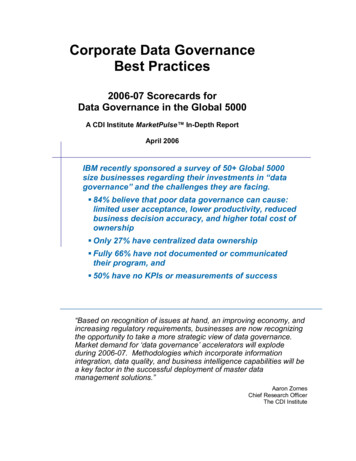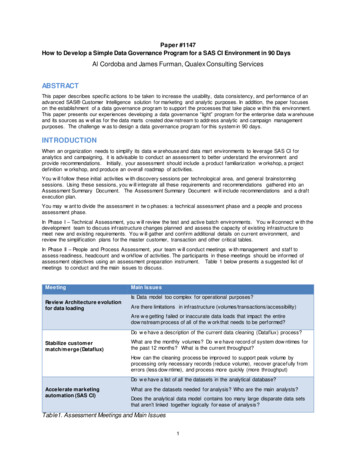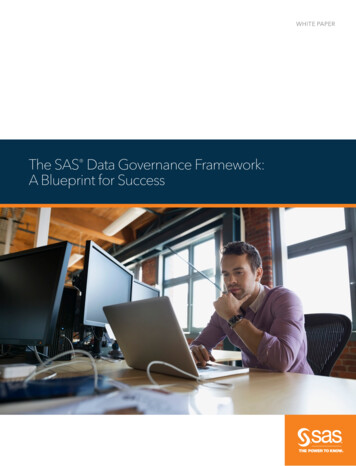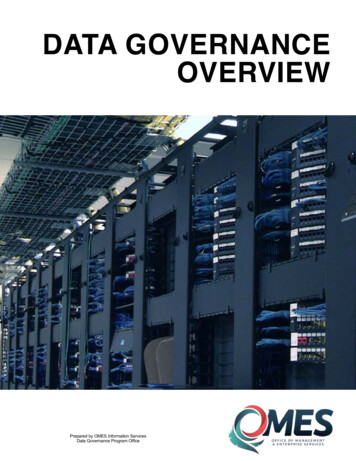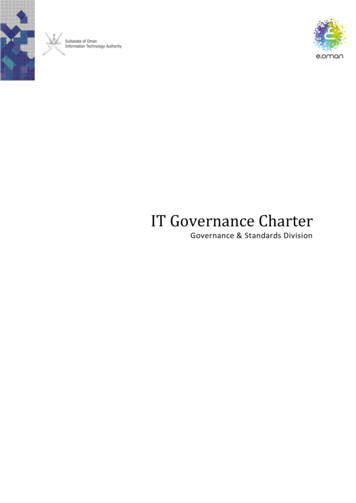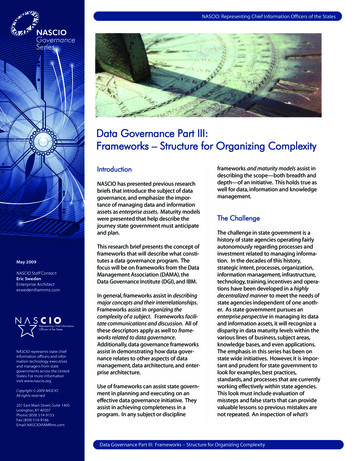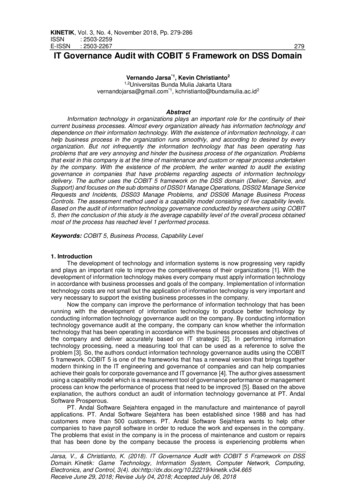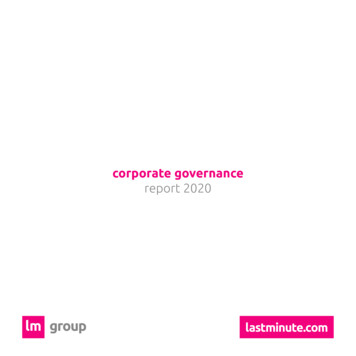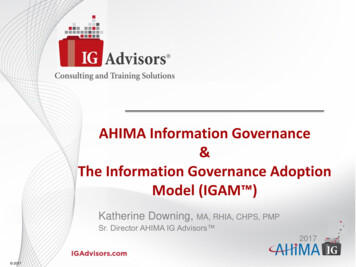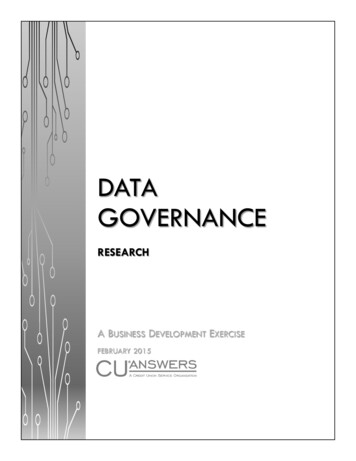
Transcription
DATAGOVERNANCERESEARCHA BUSINESS DEVELOPMENT EXERCISEFEBRUARY 2015
Business Development: “Data Governance Research”February 20, 2015Assignment to Business Developers:Spend one hour researching data governance. Write a 1-2 page document on what waslearned, explain how it could be used at CU*Answers or in your specific area in the future.Use a current event/situation and explain how data governance could be used to translateservices that you could sell or how it could improve the process.1
2
Jeff MillerData Governance“Data governance (DG) refers to the overall management of the availability, usability, integrity, andsecurity of the data employed in an enterprise. A sound data governance program includes a governingbody or council, a defined set of procedures, and a plan to execute those procedures.”1Initial review of materials suggests that data governance encompasses whatever you need it to – both inscope and in intent. Even the Data Governance Institute is vague on the subject; they indicate that it isan agreed-upon, descriptive system that is contextual, goal-driven, and follows certain principles andattempts to achieve certain general goals, but those “goals and objectives depend on the focus of aparticular Data Governance program.”Here are the goals and principles of data governance in general:Principles of Data Governance Integrity – open debate of needs, constraints, impact, fairness to all stakeholdersTransparent – clarity to participants on decisions, policies, and processesAuditable – documented and proceduralInclusive – avoiding gaps (no one is accountable) and mass overlap (too many chiefs)Stewardship – defined accountability and responsibility of contributorsBalance – between IT & business functions, between data creators, keepers, managers, usersStandardized – across the enterpriseManaged – proactive & reactive change management, structured use of data and metadataGeneral Goals of Data Governance Improve decision-makingIncrease operational effectivenessProtect needs of the stakeholdersCommon approach to data managementStandard, repeatable processTransparency of approach and processReduce cost and increase coordinationWhat Does a Data Governance Program Look Like?Data Governance is concerned with the creation of the rules and policies about data, how to regulatedata (resolve questions about data), and to create compliance and standardized approaches to datahandling. It is done with goals in mind, can start small and scale up, and is need driven (organization isgetting too large, too complex, needs standardization/integration, needs to be able to handlecompliance or audits).Boiling It DownData governance is creating the structure in terms of people, documentation, and process to ensure thatdata is appropriate, accurate, complete, and secure.3
Sources:1. ion/data-governance2. http://www.datagovernance.com/3. ads/white-papers/Role-of-Datagovernance.pdf4. http://www.sas.com/resources/whitepaper/wp 51269.pdfWhat Parts Should CU*Answers Focus On?1.2.3.4.5.Procedures & DocumentationData Security and PrivacyRegulatory ComplianceData AdministrationSystem AdministrationHow Does This Translate Into the Business Model?For CU*Answers, data governance serves as a business element in three ways. First, it is a marketingtool. CU*Answers has strong data governance and we can market this as a benefit of doing businesswith the CUSO. Second, direct products can be generated – policy and procedure documentation for useoutside the primary application, checklists, tools to support DG infrastructure/DG process itself. Finally,DG services in the form of reviews/audits, best-practice review and process updates, DG planning.1. Procedures & Documentationa. Pre-created (provided) documentation that details the policies and procedures regardingdata provenance and handling for online clients. This could be similar in form to the ACHpolicy/procedure docs issued annually by NACHA and TPA.b. “Data Governance Audit” for CU, esp. in-house. Review written policies, compare procedureto stated policy, review backup and retention strategy, provide materials on governanceprocess, retention checklist.2. Data Security and Privacya. Review of data security measures – password policy v. practice/enforcement, documentapplication security settings/configs and provide report for inclusion in boardpacket/provision for audits.b. Review of employee access to data; policies, guidelines provided.3. Regulatory Compliancea. Most regulatory action can be defined in terms of Data Governance. Frame aregulatory/best practice review in terms of Data Governance (Dodd-Frank, stress-testing,changing regulations, practice review (new uses and exposure for old data), impact ofchanging technology, quality, availability).b. Provide paid seminars/training on data governance to stakeholders - board ofdirector/management teams (“Data Governance: What You Need to Know as a Board ofDirector”, etc.).c. Provide panels to membership on “Your CU and Data Governance (brought to you by CUA)”4
4. Data Administrationa. Data Audit – what forms data takes, what happens if it needs to be accessed (all the oldpaper receipts in the basement dating back to 1997), recommendations on what to store,what not to store (cost of keeping data), risk and liability.b. Review and audit backup policy/procedure, data recovery test/checklist.5. System Administrationa. Documentation on retentionb. Audit and update on data purges, splf’s/report handling/removalc. Security and data monitoring audits/engagements5
Jim LawrenceI had heard of the term “Data Governance” but assumed it was reserved for conversations in theRecords and Information Management circles. As a result of this research project, my understanding ofDG has expanded significantly. To begin my research, I first sought some definitions. Here are a few thatI found describe it well without excess padding.Data Governance Defined “The mechanism by which an organization ensures the right corporate data is available to theright people at the right time in the right format with the right context through the rightchannels.”“The formal orchestration of people, processes, and technology to enable an organization toleverage data as an enterprise asset.”“The process by which an organization formalizes the fiduciary duty for the management of dataassets critical to its success.”In addition to information security and compliance drivers, I discovered that more and more companiesare seeking competitive advantage by leveraging data governance to proactively add value to thebottom line. It’s about getting the right information to the right people at the right time and enablingthe entire organization to seize new opportunities rather than simply operating in a reactionary way.And the windows for these revealed opportunities (as well as potential embarrassments) can be verynarrow. Businesses need to know what’s happening not just in their own organizations, but also withinall of the companies they touch, whether they are vendors, customers or partners. Having real-timeaccess to information is crucial. It is important to know where the data resides and what it is worth, andcalculate the probability of risk and cost to the organization in the event that it’s stolen.The primary goals of Data Governance include: Increasing consistency and confidence in decision making,Decreasing the risk of regulatory fines,Improving data security,Maximizing the income generation potential of data,Designating accountability for information quality,Enable better planning by supervisory staff,Minimizing or eliminating re-work,Optimize staff effectiveness,Establish process performance baselines to enable improvement efforts, andAcknowledge and hold all gains.What’s the difference between “data” and “information”?During my research, I found articles and whitepapers that seem to blur the line between “data” and“information”. Some used the terms interchangeably. Here is a simple yet effective statement thathelped me gain clarity between these two related but different objects:“Information is data placed in context, analyzed, and processed into a consumable resource or asset.”6
I learned that more and more businesses are embracing data-governance strategies to manage data(and the information it contains) that serves as the lifeblood of the company. Data has become the rawmaterial of the information economy, and data governance is a strategic imperative.Data Governance vs IT GovernanceI also experienced some confusion while reading authors who swapped IT Governance with DataGovernance, since both seemed to articulate a framework for information security. I found thisparagraph to help identify the relationship between these two disciplines:“Data Governance does not replace IT Governance but complements it. To borrow an analogycommonly used by the Data Management community, IT Governance focuses on the pipelines the organization’s IT infrastructure. Data Governance focuses on the water – the data that flowsthrough those pipelines. IT Governance focusses on defining a portfolio of IT investments,setting performance objectives, and evaluating and managing risk for the IT infrastructure. Itensures alignment of those IT investments with the organization’s mission and business goals,and it evaluates and manages enterprise-wide risks to the IT infrastructure. Data Governance,on the other hand, focuses on creating a context that enables the organization to align datamanagement efforts with business objectives, support regulatory compliance, and manage risksthat are specific to the data itself.”Data LifecycleData Governance kicks in at the source where the data enters the enterprise and continues across thelifecycle as it is processed and consumed to address business needs until it is archived and/or purged. Ifound that it applies to all business units across all the processes executed. Data Governance has a keyrole to play across all layers of the architecture: Presentation layer where the data enters the enterpriseBusiness logic layerIntegration layer where data is routedStorage layer where data finds its homeIt is imperative to understand the complete lifecycle of data, from the sources that collect and createdata, to the systems that analyze it into useful information, then to the finished reports that people relyon. Participating components of this lifecycle include:Suppliers: Understand the internal organization and external suppliers that provideinformation.Inputs and sources: Understand how data flows by identifying the people and systems thatinput, supply, and create information for the organization. This effort will produce a catalog ormap that shows where data resides. This will increase the understanding of duplicate/relevantareas and knowledge of business representatives that need to be involved in the datagovernance program.7
Processes: Understand how data flows throughout systems from source to output.Outputs: Know how data is transformed into information, and how that information ispublished and distributed in reports, live dashboards, intranet sources, or other outputs.Compare that process to the desired outcome to identify gaps to help respond to concerns thatarise when data does not meet business objectives.Customers: Assess the needs of the decision-makers that will use the data to pursue businessobjectives.Data is a valuable corporate asset, yet many companies fail to realize its full business value. Datagovernance creates an environment where companies can leverage their data quickly and efficiently torespond to challenges and opportunities posed by the market. A sound data governance programprovides formal policies, standards, and oversight that enable decision-makers to receive the accurate,timely information they need to achieve business objectives.Information SecuritySecurity should be one of main objectives of an organization’s data governance strategy. Informationhas become increasingly portable and accessible, which benefits the collaborative business environmentyet increases the risk that data will be lost, misused, or compromised. Data breaches can lead tosubstantial fines, lawsuits, and damage to a brand’s reputation. These security risks illustrate theimportance of strong data governance programs that incorporate data security. Senior executivesshould understand the value of these initiatives, because CEOs and CFOs may be held responsible forinfractions of records and information management regulations. The organization’s data governancestrategy and security management activities should align. Both initiatives will recognize that data andinformation are one of the organization’s most important assets and should be protected and leveragedto achieve business objectives.Both initiatives must also recognize that high-performing technology and knowledgably crafted policiesare useless if employees are careless with enterprise data, share passwords, take home laptops filledwith sensitive data, or do not input data so that it can be processed and shared with the organization.Data governance and security management must not fail to address people and cultural change.Data Governance must be exercised at the enterprise level with federated governance to individualbusiness units and data domains. It should be proactively exercised when a new process, application,repository or interface is introduced. Existing data is likely to be impacted. In the absence of effectiveData Governance, data is likely to be duplicated – by chance or choice. Consider these datacharacteristics: Data gets accumulated by the nanosecondData needs to be understood and analyzed to be processed and applied as meaningfulinformationData comes and goes in spurts with peaks that require an elastic infrastructure from a compute,network or storage perspective andData fallen into the wrong hands can be disastrous for individuals and enterprises.8
Employee ProductivityToday, the average employee sends and receives more than 100 emails per day, and 25 percent of thosesent contain attachments. The average employee also creates or modifies 20 or more files per day.Some of these emails and files contain business records, creating a compliance challenge involvingsorting records from non-records, and applying appropriate retention.Companies suffer from a “save everything” culture, where employees save email and documents ondesktops or file shares well past any required record retention period or beyond any remaining businessvalue. Ironically, the biggest casualty of employees’ “save everything” approach may be employeesthemselves: The average employee spends as much as six hours per week — twice what is consideredbest practice — managing, searching and identifying documents.Ann effective Data Governance program complete with awareness and standardization throughout theorganization can improve employee productivity while at the same time reducing risk.Benefits of an effective Data Governance program include: Reduce operational costs.o A well-designed data governance plan can improve the organization’s efficiency byeliminating duplicative processes and manual steps related to data input, processing,analysis, and distribution. Streamlined data management processes, enterprise-widestandards, and quality controls provide a framework in which organizations can savemoney and increase efficiency. Time and resources currently spent reconciling data oridentifying and fixing database problems can be invested elsewhere.Competitive advantage.o Decision-makers need timely, useful information to react to market conditions, respondto client and customer needs, deliver valuable products and services, and drive success.But when a company operates without a data governance program, every function setsits own rules, policies, and standards for collecting and distributing information. Thiscontent may be fractured in incompatible formats among several databases, which canmake it difficult for decision-makers to see what is happening across their organizations,prevent the development of real-time dashboards, and hinder the ability to performcomparisons.Increased business user confidence.o A strong data governance program allows decision-makers to be confident that theirinformation is reliable and up to date. It also provides a structure for identifying errorsand making corrections as soon as data management issues ariseGreater collaboration.o Without standards and quality controls, different departments are essentially speakingdifferent languages and cannot share information fluently. An effective data governanceprogram breaks down barriers to collaboration by initiating a conversation betweenrepresentatives from different functional areas about how to best use and manage data.This cross-functional communication helps eliminate the misinterpretations that occur9
when different business units make assumptions about data that different groupscapture, contribute, and share with the enterprise. Representatives from differentbusiness groups should work within the data governance model to address issues suchas accuracy, accessibility, integrity, timeliness, redundancy, consistency, privacy, andcompleteness.“Informationalization”One article that struck a chord with me during my research came from a post on the Harvard BusinessReview blog site where the author (Thomas C. Redmond) introduces a new term –“Informationalization”. Although not directly tied to Data Governance, it helps to expose theopportunities that could be lurking inside the data that already exists and cautions organizations tounderstand how they are processing/transforming it.“We are in a universe of data where its ‘informationalization’ yields valuable intelligence thatenables effective decision making and analysis. However, even having the best people, processand technology is not going to yield the desired outcomes if the underlying data is suspect.Data matters, if you glean the valuable information from it with proper context. Whenrationalizing and transforming applications as part of an enterprise transformation program, themodernization strategy applied to a given application influences the manner in which theunderlying data is processed -- it is migrated or archived or transformed or replicated -- all in thecontext of the set of applications being transformed.Five techniques to informationalize data during this process:Informationalizing through Usage. During the transformation process, we need to look at how agiven application is using the underlying data. Is it adding more context and using the data toprovide valuable information to the end user? Consider the example of knowing how cold thebeer is just by seeing the graphic on it. The applications transformation process provides a goodopportunity to check out the manner in which the data available is being used and presented.Informationalizing through Synthesis. Applications have access to data across differentrepositories. The GPS device in the car has reduced the traditional conflict with the spouse onreading maps during the journey. The GPS knows where the vehicle is positioned at any point oftime and also has information about the location of restaurants, motels, gas stations, etc. It cansynthesize this data and bring it to life by informationalizing it. Around noon each day, it candisplay a lunch icon that shows the restaurants in the nearby locale when the car is in motion xmiles away from home. Synthesis. Are the applications using the available data from multiplesources in a synthetic fashion to realize such benefits for the end user?Informationalizing Unstructured Data. We have trained ourselves over the years to operatewith structured rows and columns of data. Software available today can turn the tables oncomputers by making them thi
Feb 20, 2015 · Data Governance “Data governance (DG) refers to the overall management of the availability, usability, integrity, and security of the data employed in an enterprise. A sound data governance program includes a governing body or council, a defined set

